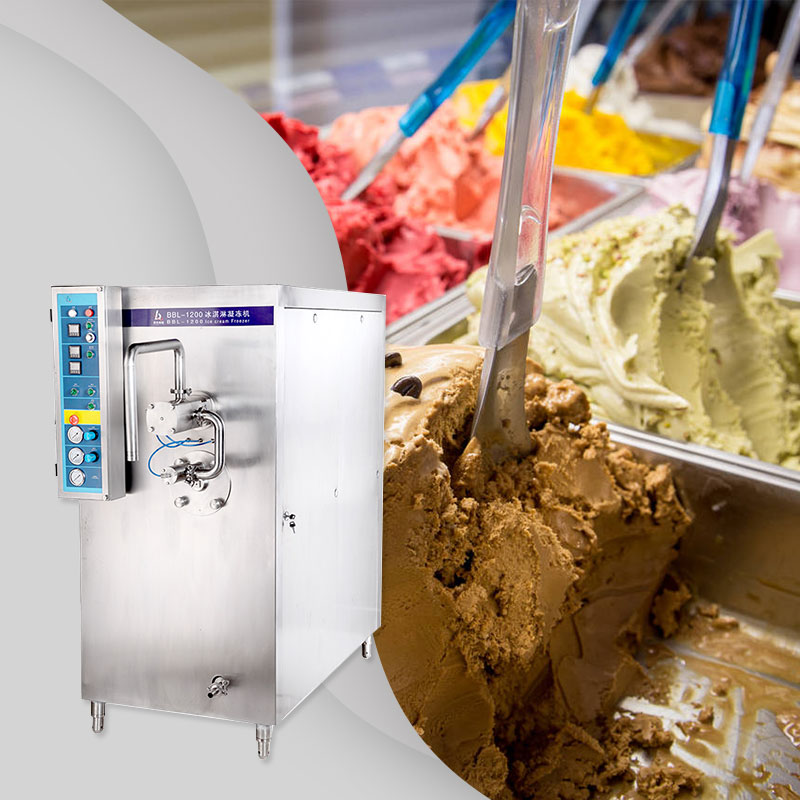The manufacturing process of ice cream can be divided i […]

The manufacturing process of ice cream can be divided into the first and second steps. The first part is mainly ingredients, homogenization, sterilization, cooling and maturation. The latter part is mainly freezing, forming and hardening. The processing process is as follows: raw material mixing, filtration, homogenization, sterilization, cooling, adding spices, maturation, freezing, filling, hardening, packaging, and storage.
1. Preparation of mixed base materials After calculating the various raw materials according to the formula, they are mixed in order according to the requirements of the processing technology. First, add the low-viscosity raw materials into the ingredient tank with the functions of sterilization, stirring and cooling, such as cow milk, skimmed milk, and condensed milk. Then add water to the solid raw materials such as sugar, milk powder, emulsifier, etc. in another container and stir. Dissolve it completely, filter and pour it into a mixing tank to mix with milk. The batching temperature at this time is about 50°C. In addition, sugar, etc. can also be made into 65% to 70% syrup for later use. Butter or hydrogenated oil can be heated first and melted before use. Stabilizers such as gelatin should be made into a 10% solution with water and then added to the mixture at about 50°C.
2.Sterilization The sterilization of the mixture can be at 75-78°C for 15 minutes. Under the condition that the quality of ice cream is not affected, sterilization conditions of 75-76°C for 20-30 minutes can also be used. Sterilization should achieve the effect of killing pathogens, bacteria, molds and yeasts, so as to ensure that the mixed bacteria in the mixture are less than 50 per milliliter.
3. Homogenization In order to make ice cream products fine and smooth, stable and long-lasting, increase expansion rate, reduce ice crystallization, etc., it is very necessary to homogenize the mixture liquid. The temperature should not be too low or too high during homogenization. The low temperature increases the viscosity of the material liquid, and the homogenization effect is not good. When freezing, the stirring time needs to be extended. If the material is homogenized at a temperature exceeding 80°C, it will promote fat accumulation and reduce the expansion rate. The homogenization pressure also has a certain range. If the pressure is too low, the homogenization effect cannot be achieved; if the pressure is too high, the stiffness of the material liquid will increase, and air will not be easily mixed in during freezing and stirring. Generally, homogenization is carried out at a pressure of 150-180 kg/cm3 under the condition of a material temperature of 63-65°C after sterilization.
4. The purpose of maturation is to fully hydrate and swell materials such as protein, fat coagulum, stabilizer, etc., increase viscosity, make the mixture have good foamability, and help increase the expansion rate during freezing and stirring and shorten the freezing time. For maturation, the materials need to be stored at 4~5℃ for 8~24 hours. When mature, the container should be covered with dust to prevent the entry of bacteria and peculiar smell. In recent years, due to the improvement of the performance of emulsifiers and stabilizers, the maturation time has been greatly shortened. Generally, it only takes 3 to 5 hours to complete the maturation.
5.Frozen Frozen is the intensive stirring of the mature mixed base material through the ice cream machine, mixing with air and freezing to make the product solidify into a semi-solid state, and obtain an ice cream product with fine and smooth tissue, good shape and high expansion rate. Therefore, freezing is an important process in the production of ice cream.Pay attention to the amount of air mixed in and the freezing temperature during production.